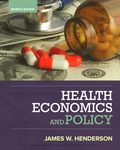
The significance of the downfall of a social system in contributing to a crisis of healthcare spending.
Explanation of Solution
Obesity is considered one of the major social issues faced by the United States of America. It is even seen as a national epidemic. Over the past fifty years, the figures of obesity have risen drastically. More than one third of the adults in the United States have been clinically declared as obese. The medical cost of an obese individual has been calculated as $1429 more than a healthy individual. 9.1% of the total medical spending in the country accounts for obesity related matters. Further, the use of alcohol and drugs has also been much instrumental in increasing the medical care spending figures. Individuals that consume alcohol and use drugs commit various illnesses in the long run. In treating such diseases, a huge cost must be borne by the country. Nevertheless, as a result of various individuals consuming alcohol and drugs, there may be other parties affected. For example, a parent consuming alcohol may abuse his or her children either physically or mentally. Treating such affected partied would also add up to the total medical spending. Teen pregnancy has also been instrumental in fueling up the healthcare spending figures. A majority of teen mothers have been identified as heavy smokers. This creates negative impacts upon the health of the mother as well as the baby. Domestic violence, another contributor to increased healthcare spending, does it in two ways. Bodily injuries caused by incidents of domestic violence and the mental trauma suffered by victims must be treated accordingly. All the factors aforesaid show the deterioration of values within society which directly and indirectly contribute to a rising cost of medical care that must be borne by a society.
Introduction:
Within the current context, one could identify a number of social problems that create a great impact upon the amounts spent on health care. Their impact has become so intense that one could in fact consider them as health issues faced by a society. Obesity, the use of alcohol and drugs, teen pregnancy and domestic violence are some examples for such social problems. These problems depict the downfall of a society and lead the society to a crisis situation where enormous amounts must be spent in relation to the healthcare of affected parties.
Want to see more full solutions like this?
Chapter 6 Solutions
EBK HEALTH ECONOMICS AND POLICY
- not use ai pleasearrow_forwardUse the following table to work Problems 5 to 9. Minnie's Mineral Springs, a single-price monopoly, faces the market demand schedule: Price Quantity demanded (dollars per bottle) 10 8 (bottles per hour) 0 1 6 2 4 3 2 4 0 5 5. a. Calculate Minnie's total revenue schedule. b. Calculate its marginal revenue schedule. 6. a. Draw a graph of the market demand curve and Minnie's marginal revenue curve. b. Why is Minnie's marginal revenue less than the price? 7. a. At what price is Minnie's total revenue maxi- mized? b. Over what range of prices is the demand for water from Minnie's Mineral Springs elastic? 8. Why will Minnie not produce a quantity at which the market demand for water is inelastic?arrow_forwardDon't give AI generated solution otherwise I will give you downward Give correct answer with explanationarrow_forward
- The Firm's Output Decision (Study Plan 12.2) Use the following table to work Problems 4 to 6. Pat's Pizza Kitchen is a price taker. Its costs are Output (pizzas per hour) Total cost (dollars per hour) 0 10 1 21 2 30 3 41 4 54 5 69 4. Calculate Pat's profit-maximizing output and economic profit if the market price is (i) $14 a pizza. (ii) $12 a pizza. (iii) $10 a pizza. 5. What is Pat's shutdown point and what is Pat's economic profit if it shuts down temporarily? 6. Derive Pat's supply curve.arrow_forwardUse the following table to work Problems 27 and 28. ProPainters hires students at $250 a week to paint houses. It leases equipment at $500 a week. The table sets out its total product schedule. Labor (students) 1 Output (houses painted per week) 2 23 5 3 9 4 12 5 14 6 15 27. If ProPainters paints 12 houses a week, calculate its total cost, average total cost, and marginal cost. At what output is average total cost a minimum? 28. Explain why the gap between ProPainters' total cost and total variable cost is the same no matter how many houses are painted.arrow_forwardUse the following table to work Problems 17 to 20. The table shows the production function of Jackie's Canoe Rides. Labor Output (rides per day) (workers per day) Plant 1 Plant 2 Plant 3 Plant 4 10 20 40 55 65 20 40 60 75 85 30 65 75 90 100 40 75 85 100 110 Canoes 10 20 30 40 Jackie's pays $100 a day for each canoe it rents and $50 a day for each canoe operator it hires. 19. a. On Jackie's LRAC curve, what is the average cost of producing 40, 75, and 85 rides a week? b. What is Jackie's minimum efficient scale?arrow_forward

 Exploring EconomicsEconomicsISBN:9781544336329Author:Robert L. SextonPublisher:SAGE Publications, Inc
Exploring EconomicsEconomicsISBN:9781544336329Author:Robert L. SextonPublisher:SAGE Publications, Inc


 Microeconomics: Private and Public Choice (MindTa...EconomicsISBN:9781305506893Author:James D. Gwartney, Richard L. Stroup, Russell S. Sobel, David A. MacphersonPublisher:Cengage Learning
Microeconomics: Private and Public Choice (MindTa...EconomicsISBN:9781305506893Author:James D. Gwartney, Richard L. Stroup, Russell S. Sobel, David A. MacphersonPublisher:Cengage Learning





